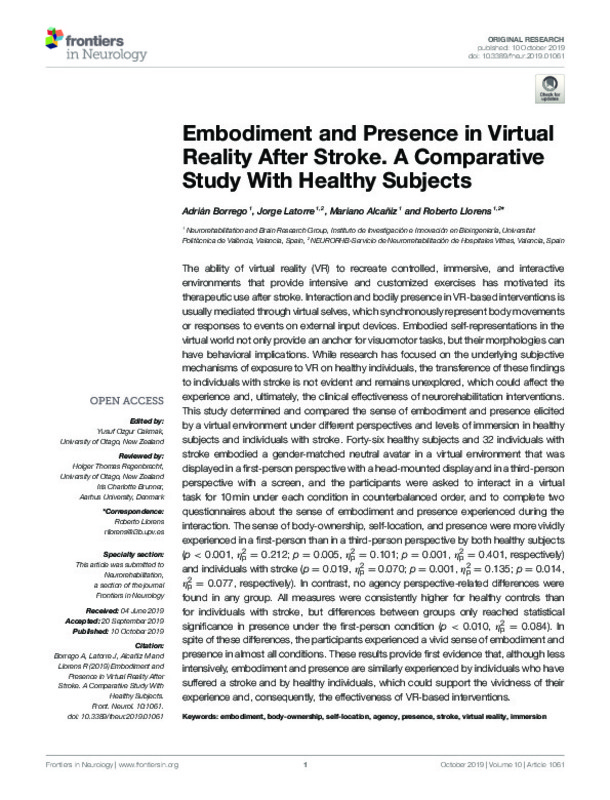Berlucchi, G., & Aglioti, S. (1997). The body in the brain: neural bases of corporeal awareness. Trends in Neurosciences, 20(12), 560-564. doi:10.1016/s0166-2236(97)01136-3
Legrand, D. (2006). The Bodily Self: The Sensori-Motor Roots of Pre-Reflective Self-Consciousness. Phenomenology and the Cognitive Sciences, 5(1), 89-118. doi:10.1007/s11097-005-9015-6
Arzy, S., Overney, L. S., Landis, T., & Blanke, O. (2006). Neural Mechanisms of Embodiment. Archives of Neurology, 63(7), 1022. doi:10.1001/archneur.63.7.1022
[+]
Berlucchi, G., & Aglioti, S. (1997). The body in the brain: neural bases of corporeal awareness. Trends in Neurosciences, 20(12), 560-564. doi:10.1016/s0166-2236(97)01136-3
Legrand, D. (2006). The Bodily Self: The Sensori-Motor Roots of Pre-Reflective Self-Consciousness. Phenomenology and the Cognitive Sciences, 5(1), 89-118. doi:10.1007/s11097-005-9015-6
Arzy, S., Overney, L. S., Landis, T., & Blanke, O. (2006). Neural Mechanisms of Embodiment. Archives of Neurology, 63(7), 1022. doi:10.1001/archneur.63.7.1022
De Vignemont, F. (2011). Embodiment, ownership and disownership. Consciousness and Cognition, 20(1), 82-93. doi:10.1016/j.concog.2010.09.004
Giummarra, M. J., Gibson, S. J., Georgiou-Karistianis, N., & Bradshaw, J. L. (2008). Mechanisms underlying embodiment, disembodiment and loss of embodiment. Neuroscience & Biobehavioral Reviews, 32(1), 143-160. doi:10.1016/j.neubiorev.2007.07.001
Ma, K., & Hommel, B. (2015). The role of agency for perceived ownership in the virtual hand illusion. Consciousness and Cognition, 36, 277-288. doi:10.1016/j.concog.2015.07.008
Kilteni, K., Maselli, A., Kording, K. P., & Slater, M. (2015). Over my fake body: body ownership illusions for studying the multisensory basis of own-body perception. Frontiers in Human Neuroscience, 9. doi:10.3389/fnhum.2015.00141
Clark, A., Kiverstein, J., & Vierkant, T. (Eds.). (2013). Decomposing the Will. doi:10.1093/acprof:oso/9780199746996.001.0001
Frith, C. D., Blakemore, S.-J., & Wolpert, D. M. (2000). Abnormalities in the awareness and control of action. Philosophical Transactions of the Royal Society of London. Series B: Biological Sciences, 355(1404), 1771-1788. doi:10.1098/rstb.2000.0734
Bermúdez i Badia, S., Fluet, G. G., Llorens, R., & Deutsch, J. E. (2016). Virtual Reality for Sensorimotor Rehabilitation Post Stroke: Design Principles and Evidence. Neurorehabilitation Technology, 573-603. doi:10.1007/978-3-319-28603-7_28
Perez-Marcos, D., Sanchez-Vives, M. V., & Slater, M. (2011). Is my hand connected to my body? The impact of body continuity and arm alignment on the virtual hand illusion. Cognitive Neurodynamics, 6(4), 295-305. doi:10.1007/s11571-011-9178-5
IJsselsteijn, W. A., de Kort, Y. A. W., & Haans, A. (2006). Is This My Hand I See Before Me? The Rubber Hand Illusion in Reality, Virtual Reality, and Mixed Reality. Presence: Teleoperators and Virtual Environments, 15(4), 455-464. doi:10.1162/pres.15.4.455
Banakou, D., Groten, R., & Slater, M. (2013). Illusory ownership of a virtual child body causes overestimation of object sizes and implicit attitude changes. Proceedings of the National Academy of Sciences, 110(31), 12846-12851. doi:10.1073/pnas.1306779110
Yee, N., & Bailenson, J. (2007). The Proteus Effect: The Effect of Transformed Self-Representation on Behavior. Human Communication Research, 33(3), 271-290. doi:10.1111/j.1468-2958.2007.00299.x
Steed, A., Frlston, S., Lopez, M. M., Drummond, J., Pan, Y., & Swapp, D. (2016). An ‘In the Wild’ Experiment on Presence and Embodiment using Consumer Virtual Reality Equipment. IEEE Transactions on Visualization and Computer Graphics, 22(4), 1406-1414. doi:10.1109/tvcg.2016.2518135
Colomer, C., Llorens, R., Noé, E., & Alcañiz, M. (2016). Effect of a mixed reality-based intervention on arm, hand, and finger function on chronic stroke. Journal of NeuroEngineering and Rehabilitation, 13(1). doi:10.1186/s12984-016-0153-6
Laver, K. E., Lange, B., George, S., Deutsch, J. E., Saposnik, G., & Crotty, M. (2017). Virtual reality for stroke rehabilitation. Cochrane Database of Systematic Reviews. doi:10.1002/14651858.cd008349.pub4
Llorens, R., Borrego, A., Palomo, P., Cebolla, A., Noé, E., i Badia, S. B., & Baños, R. (2017). Body schema plasticity after stroke: Subjective and neurophysiological correlates of the rubber hand illusion. Neuropsychologia, 96, 61-69. doi:10.1016/j.neuropsychologia.2017.01.007
Zeller, D., Gross, C., Bartsch, A., Johansen-Berg, H., & Classen, J. (2011). Ventral Premotor Cortex May Be Required for Dynamic Changes in the Feeling of Limb Ownership: A Lesion Study. Journal of Neuroscience, 31(13), 4852-4857. doi:10.1523/jneurosci.5154-10.2011
Folstein, M. F., Folstein, S. E., & McHugh, P. R. (1975). «Mini-mental state». Journal of Psychiatric Research, 12(3), 189-198. doi:10.1016/0022-3956(75)90026-6
Romero, M., Sánchez, A., Marín, C., Navarro, M. D., Ferri, J., & Noé, E. (2012). Clinical usefulness of the Spanish version of the Mississippi Aphasia Screening Test (MASTsp): validation in stroke patients. Neurología (English Edition), 27(4), 216-224. doi:10.1016/j.nrleng.2011.06.001
Latorre, J., Llorens, R., Colomer, C., & Alcañiz, M. (2018). Reliability and comparison of Kinect-based methods for estimating spatiotemporal gait parameters of healthy and post-stroke individuals. Journal of Biomechanics, 72, 268-273. doi:10.1016/j.jbiomech.2018.03.008
Lloréns, R., Noé, E., Naranjo, V., Borrego, A., Latorre, J., & Alcañiz, M. (2015). Tracking Systems for Virtual Rehabilitation: Objective Performance vs. Subjective Experience. A Practical Scenario. Sensors, 15(3), 6586-6606. doi:10.3390/s150306586
Slater, M., & Steed, A. (2000). A Virtual Presence Counter. Presence: Teleoperators and Virtual Environments, 9(5), 413-434. doi:10.1162/105474600566925
Slater, M., Spanlang, B., Sanchez-Vives, M. V., & Blanke, O. (2010). First Person Experience of Body Transfer in Virtual Reality. PLoS ONE, 5(5), e10564. doi:10.1371/journal.pone.0010564
Petkova, V. I., Khoshnevis, M., & Ehrsson, H. H. (2011). The Perspective Matters! Multisensory Integration in Ego-Centric Reference Frames Determines Full-Body Ownership. Frontiers in Psychology, 2. doi:10.3389/fpsyg.2011.00035
Maselli, A., & Slater, M. (2013). The building blocks of the full body ownership illusion. Frontiers in Human Neuroscience, 7. doi:10.3389/fnhum.2013.00083
Debarba, H. G., Molla, E., Herbelin, B., & Boulic, R. (2015). Characterizing embodied interaction in First and Third Person Perspective viewpoints. 2015 IEEE Symposium on 3D User Interfaces (3DUI). doi:10.1109/3dui.2015.7131728
Burin, D., Livelli, A., Garbarini, F., Fossataro, C., Folegatti, A., Gindri, P., & Pia, L. (2015). Are Movements Necessary for the Sense of Body Ownership? Evidence from the Rubber Hand Illusion in Pure Hemiplegic Patients. PLOS ONE, 10(3), e0117155. doi:10.1371/journal.pone.0117155
Post-stroke cognitive disorders TeasellR SalterK FaltynekP CotoiA EskesG Evidence-Based Review of Stroke Rehabilitation
[-]









